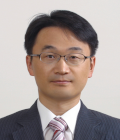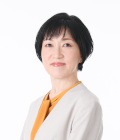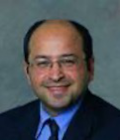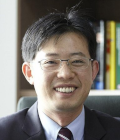Plenary lectures
Multi-Physics of Electrohydrodynamic Jet and Application to Printing Technology for Electronics Manufacturing
Prof. Doyoung Byun
Sungkyunkwan University
Prof. Doyoung Byun
Sungkyunkwan University

Abstract
Recently, as the technology and market for printing-based devices continue to grow, the demand for high-resolution printing technology has rapidly increased. Solution-based inkjet printing fabrication processes have advantages of rapid and large-area fabrication, low cost, and easy tunability. The electrohydrodynamic (EHD) inkjet printing method is one of the advanced printing techniques that has been suggested as an alternative. The EHD jet printing uses a force balance of electrical force and fluid dynamics to control jetting phenomena. This allows for smaller droplet generation than the nozzle size and ejection of a wide range of ink viscosity. Due to these advantages, more precise and smaller patterning of different materials, such as silver or quantum dot (QD) inks in microscales, is possible. In this talk, the successful contribution of EHD inkjet technology for OLED and micro-LED display development will be introduced. Ones could fabricate the bond-pads for transferring chips and repair the electrodes of display panels. Ones also could make uniform small dots of QDs. Based on fundamental studies of EHD inkjet printing mechanism and ink materials, EHD inkjet printhead and printing system have been developed, which show high performance of high-resolution printing and high production capability. Here, the research on EHD inkjet printing is reviewed, including the basic multi-physics and wide applications in electronics and displays.
Biography
Doyoung Byun received his PhD from the Korea Advanced Institute of Science and Technology (KAIST) in 2000. After completing his degree, he joined the aerospace engineering department in Konkuk university in 2002 and moved to the mechanical engineering department at Sungkyunkwan University in 2012. He founded Enjet co Ltd., a spin-off start-up company from his research laboratory, in 2009. He has published over 140 peer-reviewed journal papers and has been awarded 100 patents. His expertise lies in microfluidics and inkjet printing technologies, specifically in the development of novel electrohydrodynamic (EHD) jet printing and liquid dispensing technologies, and MEMS devices. Based on fundamental understanding of droplet generation and behavior on substrates, he has successfully commercialized ultra-fine printing and spray coating tools for a variety of industries, including the display, mobile phone, battery, and biomedical industries.
Tackling Real World Fluid Flow Problems via Numerical Simulations: From Aquatic Swimming and Heart Valves to River Flooding and Wind Energy
Prof. Fotis Sotiropoulos
Virginia Commonwealth University
Prof. Fotis Sotiropoulos
Virginia Commonwealth University

Abstract
Simulation-based engineering science has emerged as a powerful approach for tackling the major societal problems of our time related to human health, environmental sustainability, and renewable energy. Fluid mechanics problems frequently at the center of many of these challenges are often so complex that simulation-based research is the only viable approach for tackling them. Examples include: understanding disease promoting blood flow patterns in the human heart, developing innovative bioinspired swimming robots, assessing and mitigating the risk of extreme flooding in waterways, and optimizing systems for harnessing renewable energy from wind, currents, and waves. Accurate numerical simulation of such flows poses a formidable challenge to even the most advanced computational methods available today. In this talk I will discuss the advances we have made in my group over the last two decades to develop a powerful high-fidelity computational framework, the Virtual Flow Simulator (VFS), which can: handle arbitrarily complex geometries encountered in real-life applications; simulate fluid-structure interaction for rigid and flexible bodies; account for two-phase flows and free surface effects; and carry out large-eddy simulations (LES) of turbulent flows in arbitrarily complex domains with dynamically evolving boundaries. The ability of the method to yield striking new insights into the physics of a broad range of real-life problems will be demonstrated by discussing applications in aquatic biology, cardiovascular bio-engineering, turbulence and transport processes in natural waterways, and wind and marine and hydrokinetic energy. Exciting opportunities and recent results illustrating the promise of using machine learning to augment the predictive power of LES to develop an efficient high-fidelity framework for engineering design and optimization of complex flow systems will also be presented.
Biography
Fotis Sotiropoulos serves as the Provost and Senior Vice President for Academic Affairs and a professor of Nuclear and Mechanical Engineering at Virginia Commonwealth University. Prior to that he was: Dean of the College of Engineering and Applied Sciences and State University of New York (SUNY) Distinguished Professor at Stony Brook University (2015-2021); the James L. Record Professor of Civil Engineering and director of the St. Anthony Falls Laboratory at the University of Minnesota, Twin Cities (2006-2015); and on the faculty of the School of Civil and Environmental Engineering at the Georgia Institute of Technology, with a joint appointment in the G. W. Woodruff School of Mechanical Engineering (1995-2005). His research focuses on simulation-based engineering science for tackling complex, societally relevant fluid mechanics problems in renewable energy, environmental, biological and human health applications. He has authored over 200 peer reviewed journal papers and book chapters and his research has been featured on the cover of several prestigious journals. He is fellow of the American Physical Society (APS) and the American Society of Mechanical Engineers (ASME), and the recipient of the 2023 ASME Fluids Engineering Award, 2019 American Geophysical Union (AGU) Borland Lecture award, and the 2017 Hunter Rouse Hydraulic Engineering Award (ASCE). He has twice won the APS Division of Fluid Dynamics Gallery of Fluid Motion (2009, 2011), and is a 2014 distinguished lecturer of the Mortimer and Raymond Sackler Institute of Advanced Studies at Tel Aviv University.
Evaluation of railway vehicles' resistance against strong crosswinds and its application for safe railway operation
Dr. Yayoi Misu
East Japan Railway Company
Dr. Yayoi Misu
East Japan Railway Company

Abstract
The history of railways includes not only increased transportation capacity, track length, and speed of trains but also enhanced safety in train operations. Japan has faced strong wind accidents due to meteorological conditions and narrow-gauge track structures since the dawn of railways. With recent advancements in train speed, weight reduction of vehicles, and intensification of weather phenomena, ensuring the safety of trains against strong crosswinds is a critical issue in the railway field. This talk introduces the evaluation of railway vehicles' resistance against strong crosswinds, including static or dynamic analysis of the behavior of railway vehicles against strong winds and aerodynamic force measurements using wind tunnel tests. A regulation method for safe railway operations in Japan will also be discussed, combined with the resistance evaluation and wind observations.
Biography
Dr. Yayoi Misu joined East Japan Railway Company in 1998 after graduating from Waseda University with an M.S. degree in mechanical engineering. In 2006, she also received an M.S. degree in civil engineering from MIT. She then earned a Ph.D. in civil engineering from the University of Tokyo for her research on a strong wind prediction method for railway operation. She currently serves as the Principal Chief Researcher in the Safety Research Laboratory at the Research and Development Center, where she is working to enhance safety of railway vehicles by preventing phenomena such as derailment and turnover.
Data-driven learning of turbulence
Prof. Changhoon Lee
Yonsei University
Prof. Changhoon Lee
Yonsei University

Abstract
Our understanding of turbulence has been made deeper thanks to the development of surpercomputers over the last 50 years. Based on the accumulated knowledges on turbulence, prediction of turbulence to a certain extent became possible and thus simulations using RANS or LES models have been actively carried out for various purposes in wide range of industrial applications. However, owing to the multi-scale nature and strongly nonlinear interactions between different scales of turbulence, both the reliable accuracy of prediction and reasonable speed of simulation cannot be achieved to the satisfactory level. This is obviously caused by the limitation of the PDE-based approach which attempts to resolve the solution in 4D spatio-temporal space. As a remedy to this hurdle, data-driven learning was recently proposed and have been actively applied to various turbulence problems. For the last several years, we have explored deep learning in various turbulence problems such as inflow generation, super-resolution reconstruction, prediction of turbulent heat transfer, reinforcement learning for the subgrid-scale model of LES, reinforcement of learning of turbulence for drag reduction and station data-driven weather prediction. Based on our experience with deep learning, I am going to discuss the feasibility and prospect of data-driven learning of turbulence in the talk.
Biography
Changhoon Lee is Professor of Department of Mechanical Engineering in Yonsei University and jointly affiliated with School of Mathematics and Computing in Yonsei University. Since he obtained PhD from University of California at Berkeley in 1993, he has been working on turbulence control, particle-laden turbulence, fractal modeling of turbulence, numerical algorithm and pollutant dispersion in urban environment. Recently, his group has been applying deep learning to wide range of turbulence problems. He has authored over 100 journal papers and is currently an associate editor of Journal of Computational Science and Scientific Reports. He is the chair of the Korean Society of Computational Science and Engineering. He served as an editorial board member of Physical Review Fluids and the past chair of Fluid Engineering Division of the Korean Society of Mechanical Engineers.
Impact of 3D inverse design and optimization on solving challenging problems in design of rotodynamic pumps
Prof. Mehrdad Zangeneh
University college London
Prof. Mehrdad Zangeneh
University college London

Abstract
Pump manufacturers face many challenges such as legislative pressures to improve efficiency ( e.g ECOdesign directive in EU, US DOE pump energy efficiency standards) as well as competitive pressure to reduce cost and developments times. Many of these challenges require innovative design solutions that can solve multi-point/multi-objective and multi-disciplinary problems.
In this presentation we will review the impact of 3D inverse design method on solving some of the challenging problems in design of rotodynamic pumps such as control of secondary flows in centrifugal and mixed flow impellers, control of corner separation in vaned bowl diffusers and also control of cavitation. We will outline the advantages of 3D inverse design based geometry parametrization for surrogate model based optimization, which can help to solve difficult multi-point/ multi-objective problems in rotodynamic pumps. We will also show three key areas where inverse design can lead to a paradigm shift in design of rotodynamic pumps in future. One area is design of pumps with compact size but with controlled cavitation erosion, leading to reductions in costs. The second is how a surrogate model based machine learning approach can create an expert system to rapidly explore design space for trade-offs. The third key area is the ease with which the 3D inverse design can enable designers to benefit from the potential of 3D printing and additive manufacturing.
Biography
Mehrdad Zangeneh is Professor of Thermofluids at University College London and Founding Director of Advanced Design Technology Ltd. He received his BSc from London University and PhD from Cambridge University. For the past 30 years he has been involved in development of advanced turbomachinery design codes based on 3D inverse design approach and automatic optimization to turbomachinery design. His research has resulted in important breakthroughs in turbomachinery design and he has been granted 7 international patents. He has received a number of awards from Institute of Mechanical Engineers and Turbomachinery Society of Japan.
X-ray Flow Visualization: Techniques and Applications
Prof. Theodore (Ted) J. Heindel
Iowa State University
Prof. Theodore (Ted) J. Heindel
Iowa State University

Abstract
Multiphase flows, defined as a discrete phase in a continuous fluid phase, are found in many natural, industrial, and consumer flows, from rain fall and avalanches to petroleum processing and fuel combustion to cookie dough mixing and pasta making. Many of these flows have an interior that is hidden to optical flow measurements, and intrusive probes can modify the flows of interest. Noninvasive measurement techniques, like X-ray flow visualization, provide a means to visualize and quantify the flow conditions in areas obstructed to visual access. Additionally, X-rays are unlikely to modify the local flow conditions. This presentation will review various X ray flow visualization techniques, including those using X-rays from tube sources, electron guns, and synchrotron sources. X-ray fundamentals will first be reviewed, and then various techniques will be highlighted using specific applications that involve gas-liquid flows, gas-solid flows, and granular flows. Advantages and disadvantages of each technique will be highlighted and the unique flow features that can be captured with X-ray flow visualization will be detailed.
Biography
Theodore J. Heindel is a University Professor and the Bergles Professor of Thermal Science in the Department of Mechanical Engineering at Iowa State University. He is also the Director of the Center for Multiphase Flow Research and Education (CoMFRE) at ISU. His Experimental Multiphase Flow Laboratory houses a one-of-a-kind instrument for performing X-ray visualization studies of complex fluid flows. His research currently focuses on multiphase flow hydrodynamics (e.g., mixing in gas-liquid, gas-solid, and particle-particle flows) and multiphase flow visualization and characterization using X-ray imaging technology. His research program has been supported through the NSF, USDA, DOE, ONR, and industrial partners. He has co-authored one book and published over 100 peer-reviewed journal papers and nearly 300 conference papers, abstracts, and technical reports. He is currently an associate editor for the International Journal of Multiphase Flow. Ted has been recognized at Iowa State with the College of Engineering D.R. Boylan Eminent Faculty Award for Research in 2022, a Regents Award for Faculty Excellence in 2018, the Exemplary Faculty Mentor Award in 2014, the College of Engineering’s Superior Engineering Teacher of the Year Award in 2006, and was twice selected by graduating seniors as mechanical engineering’s Professor of the Year. He is a Fellow in the American Society of Mechanical Engineers, a past associate editor for the ASME Journal of Fluids Engineering, and the past chair of the ASME Fluids Measurement and Instrumentation Technical Committee. He received his B.S. from the University of Wisconsin – Madison and his M.S. and Ph.D. from Purdue University, all in mechanical engineering with an emphasis in the thermal sciences.
Coherent structures and transport phenomena in turbulence
Prof. Susumu Goto
Osaka University
Prof. Susumu Goto
Osaka University

Abstract
Through recent numerical simulations, it is now evident that high-Reynolds-number turbulence is composed of a hierarchy of well-organized structures with various sizes. The picture of coherent structures is useful to explain the physical mechanism of some transport phenomena, such as particle clustering in turbulence and turbulence attenuation by solid particles. In this talk, I will show concrete examples of studies from this perspective.
Biography
Profile:
1999 Ph.D, Graduate University for Advanced Studies
2003 Visiting Researcher, Imperial College, London
2004 Research Associate, Kyoto University
2010 Associate Professor, Okayama University
2015 Professor, Osaka University
Specialty area:
Engineering science of fluid mechanics
Real-Time High-Fidelity Simulations of Urban Microclimates
Prof. Jung-Il Choi
Yonsei University
Prof. Jung-Il Choi
Yonsei University

Abstract
We present a high-fidelity large-eddy simulation (LES) approach for analyzing urban microclimates, which is essential for urban planning, safety, and the effective operation of urban aerial mobility (UAM). Our approach utilizes the monolithic projection method with staggered time discretization, enhancing computational performance while preserving accuracy. The immersed boundary method is incorporated to resolve complex urban geometries on Cartesian grids accurately. The Synthetic Eddy method generates artificial turbulent inflow based on Weather Research and Forecasting (WRF) data, facilitating efficient simulation of turbulent flows. GPU computation addresses the speed limitations of CPU-based methods and memory constraints of single GPU-based methods. This lecture will discuss the monolithic projection method, immersed boundary method formulations, and scalability assessments with multiple GPUs. Moreover, we will demonstrate real terrain calculations, offering valuable insights and charting future research directions in high-fidelity urban microclimate simulations.
Biography
Jung-Il Choi is a professor at the School of Mathematics and Computing (Computational Science and Engineering) in Yonsei University. He obtained his B.S., M.S., and Ph.D. in mechanical engineering from KAIST. After positions at the University of North Carolina at Chapel Hill and North Carolina State University, he joined Yonsei University in 2010. As director of the Multi-Physics Modeling and Computation (MPMC) Lab, Choi focuses on developing physics-based, data-driven modeling and computing techniques for multi-physics and multi-scale problems in energy and environmental applications. His primary research interests include real-time simulations of urban microclimates and battery modeling/diagnostic algorithms.
On the Dynamics of Single Bubbles
Prof. Akio Tomiyama
Kobe University
Prof. Akio Tomiyama
Kobe University

Abstract
Although an enormous number of studies on bubble dynamics have been carried out so far, many important characteristics of the bubble dynamics still remain unrevealed. Among them, some fundamental issues will be discussed, i.e., what we know and what we do not know on the drag coefficient of a single bubble in a stagnant liquid, the lift coefficient of a bubble in a simple shear flow, and the Sherwood number of a single bubble dissolving in the liquid will be summarized based on my experience. Experimental data on terminal rising velocities of single bubbles in stagnant liquid in infinite or confined domain have been utilized for developing drag models. A question, however, arises as to their applicability to a bubble in a condition other than the stagnant liquid. This problem will be discussed based on some theoretical analyses of the mechanism governing the terminal rising velocities. Our understanding on the lift coefficient is still in its infancy. Though the number of available lift coefficient data is still too small to cover a wide range of bubble diameters and fluid properties, some progress has recently been made through an international collaboration between HZDR in Germany, IMFT in France and Kobe U. in Japan. HZDR has obtained lift data in clean and contaminated air bubbles in water, whereas Kobe U. has measured lift coefficients of bubbles in viscous systems. These data have been analyzed based on physical insights suggested by IMFT that the lift force should be tightly related with the drag force and the interaction between the incoming vorticity and the vorticity generated at the bubble surface plays a key role in generation of negative lift force. The knowledge obtained so far will be summarized and challenges that should be made in the future will be remarked. Mass transfer from a bubble is of great importance in many practical systems, but again experimental data on mass transfer rates or the Sherwood number are still insufficient to develop reliable mass transfer models. Recent findings on effects of electrolyte, surfactant and chemical absorption on mass transfer will be introduced with remarks for future work.
Biography
Akio Tomiyama is a Professor at Kobe University since 2003. He obtained his PhD from Tokyo Institute of Technology. He was formerly a Researcher at the Energy Research Lab. at Hitachi Ltd. in 1984-1988, a research Associate (1988-1991) and associate professor (1991-2002) and Dean of Faculty of Engineering (2015-2019) at Kobe University. His main research areas are multi-scale CFD for multiphase flows, experiments and modeling of bubble dynamics and gas-liquid two-phase flows. He has received several best paper awards and outstanding achievement awards from Japan Society of Mechanical Engineers, Japanese Society of Multiphase Flows and Japan Atomic Energy Society. He is serving as the editor-in-chief of Multiphase Science and Technology and a member of editorial advisory board of Int. J. Heat and Fluid Flow, and had been an associate editor of Int. J. Multiphase Flow for 16 years. He has also served as the President of Japanese Society for Multiphase Flow and a Governing Board member of Int. Conf. Multiphase Flow.